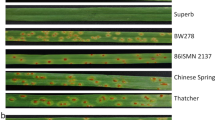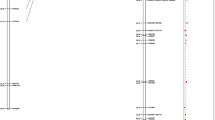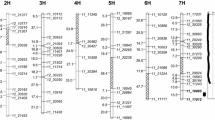Abstract
Leaf stripe of barley, caused by Pyrenophora graminea, is an important seed-borne disease in organically grown as well as in conventionally grown Nordic and Mediterranean barley districts. Two barley segregating populations represented by 103 recombinant inbred lines (RILs) of the cross L94 (susceptible) × Vada (resistant) and 194 RILs of the cross Arta (susceptible) × Hordeum spontaneum 41-1 (resistant) were analysed with two highly virulent leaf stripe isolates, Dg2 and Dg5, to identify loci for P. graminea resistance. A major gene with its positive allele contributed by Vada and H. spontaneum 41-1 was detected in both populations and for both pathogen isolates on chromosome 2HL explaining 44.1 and 91.8% R 2, respectively for Dg2 and Dg5 in L94 × Vada and 97.8 and 96.1% R 2, respectively for Dg2 and Dg5 in Arta × H. spontaneum 41-1. Common markers in the gene region of the two populations enabled map comparison and highlighted an overlapping for the region of the resistance locus. Since the map position of the resistance locus identified in this report is the same as that for the leaf stripe resistance gene Rdg1a, mapped earlier in Alf and derived from the ‘botanical’ barley line H. laevigatum, we propose that leaf stripe resistance in Vada and H. spontaneum 41-1 is governed by the same gene, namely by Rdg1a, and that Rdg1a resistance could be traced back to H. spontaneum, the progenitor of cultivated barley. PCR-based molecular markers that can be used for marker-assisted selection (MAS) of Rdg1a were identified. An Rdg1a syntenic interval with the rice chromosome arm 4L was identified on the basis of rice orthologs of EST-based barley markers. Analysis of the rice genes annotated into the syntenic interval did not reveal sequences strictly belonging to the major class (nucleotide-binding site plus leucine-rich repeat) of the resistance genes. Nonetheless, four genes coding for domains that are present in the major disease-resistance genes, namely receptor-like protein kinase and ATP/GTP-binding proteins, were identified together with a homolog of the barley powdery mildew resistance gene mlo. Three (out of five) homologs of these genes were mapped in the Rdg1a region in barley and the mlo homolog map position was tightly associated with the LOD score peak in both populations.





Similar content being viewed by others
References
Arru L, Niks RE, Lindhout P, Valè G, Francia E, Pecchioni N (2002) Genomic regions determining resistance to leaf stripe (Pyrenophora graminea) in barley. Genome 45:460–466
Arru L, Faccini N, Govoni C, Cattivelli L, Pecchioni N, Delogu G, Stanca AM, Valè G (2003a) The PCR-based marker MWG2018 linked to the Rdg2a leaf stripe resistance gene is a useful tool for assessing barley resistance in breeding programs. Crop Sci 43:1036–1042
Arru L, Francia E, Pecchioni N (2003b) Isolate-specific QTLs of resistance to leaf stripe (Pyrenophora graminea) in the ‘Steptoe’ × ‘Morex’ spring barley cross. Theor Appl Genet 106:668–675
Asfaw Z, von Bothmer R (1990) Hybridization between landrace varieties of Ethiopian barley (Hordeum vulgare ssp. vulgare) and the progenitor of barley (H. vulgare ssp. spontaneum). Hereditas 112:57–64
Baum M, Grando S, Backes G, Jahoor A, Sabbagh A, Ceccarelli S (2003) QTLs for agronomic traits in the Mediterranean environment identified in recombinant inbred lines of the cross ‘Arta’ × H. spontaneum 41–1. Theor Appl Genet 107:1215–1225
Becker J, Heun M (1995) Barley microsatellites: allele variation and mapping. Plant Mol Biol 27:835–845
Boulif M, Wilcoxson RD (1988) Inheritance of resistance to Pyrenophora graminea in barley. Plant Dis 72:233–238
Boutin-Ganache I, Raposo M, Raymond M, Deschepper CF (2001) M13-tailed primers improve the readability and usability of microsatellite analyses performed with two different allele sizing methods. Bio-Techniques 31:24–27
Brueggeman R, Rostoks N, Kudrna D, Kilian A, Han F, Chen J, Druka A, Steffenson B, Kleinhofs A (2002) The barley stem rust-resistance gene Rpg1is a novel disease-resistance gene with homology to receptor kinases. Proc Natl Acad Sci USA 99:9328–9333
Brunner S, Keller B, Feuillet C (2003) A large rearrangement involving genes and low-copy DNA interrupts the microcollinearity between rice and barley at the Rph7 locus. Genetics 164:673–683
Bulgarelli D, Collins NC, Tacconi G, Dall’Aglio E, Brueggeman R, Kleinhofs A, Stanca AM, Valè G (2004) High-resolution genetic mapping of the leaf stripe resistance gene Rdg2a in barley. Theor Appl Genet 108:1401–1408
Chen A, Brŭlé-Babel A, Baumann U, Collins NC (2009) Structure–function analysis of the barley genome: the gene-rich region of chromosome 2HL. Funct Integr Genomics 9:67–79
Delogu G, Porta-Puglia A, Stanca AM, Vannacci G (1995) Interaction between barley and Pyrenophora graminea: an overview of research in Italy. Rachis 14:29–34
Devos KM (2005) Updating the ‘Crop Circle’. Curr Opin Plant Biol 8:155–162
Dilbirligi M, Erayman M, Gill KS (2005) Analysis of recombination and gene distribution in the 2L1.0 region of wheat (Triticum aestivum L.) and barley (Hordeum vulgare L.). Genomics 8:47–54
Fetch TG, Steffenson BJ, Nevo E (2003) Diversity and sources of multiple disease resistance in Hordeum spontaneum. Plant Dis 87:1439–1448
Gatti A, Rizza F, Delogu G, Terzi V, Porta-Puglia A, Vannacci G (1992) Physiological and biochemical variability in a population of Drechslera graminea. J Genet Breed 46:179–186
Giese H, Holm-Jensen AG, Jensen HP, Jensen J (1993) Localization of the Laevigatum powdery mildew resistance gene to barley chromosome 2 by the use of RFLP markers. Theor Appl Genet 85:897–900
Golzar H (1995) Barley leaf blights in Iran. Rachis 14:41
Haegi A, Bonardi V, Dall’Aglio E, Glissant D, Tumino G, Collins N, Bulgarelli D, Infantino A, Stanca AM, Delledonne M, Valè G (2008) Histological and molecular analysis of Rdg2a barley resistance to leaf stripe. Mol Plant Pathol 9:463–478
Hammond-Kosack K, Parker JE (2003) Deciphering plant pathogen communication: fresh perspectives for molecular resistance breeding. Curr Opin Biotech 14:177–193
Han F, Kilian A, Chen JP, Kudrna D, Steffenson B, Yamamoto K, Matsumoto T, Sasaki T, Kleinhofs A (1999) Sequence analysis of a rice BAC clone covering the syntenous barley Rpg1 region. Genome 42:1071–1076
Hinze K, Thompson RD, Ritter E, Salamini F, Schulze-Lefert P (1991) RFLP-mediated targeting of the mlo resistance locus in barley (Hordeum vulgare). Proc Natl Acad Sci USA 88:3691–3695
Kosambi DD (1944) The estimation of map distances from recombination values. Ann Eugen 12:172–175
Kraakman ATW, Martìnez F, Mussiraliev B, van Eeuwijk FA, Niks RE (2006) Linkage disequilibrium mapping of morphological, resistance, and other agronomically relevant traits in modern spring barley cultivars. Mol Breed 17:41–58
Künzel G, Korzun L, Meister A (2000) Cytologically integrated physical restriction fragment length polymorphism maps for the barley genome based on translocation breakpoints. Genetics 154:397–412
Mammadov JA, Steffenson BJ, Saghai-Maroof MA (2005) High-resolution genetic mapping of the barley leaf rust resistance gene Rph5 using barley expressed sequence tags (ESTs) and synteny with rice. Theor Appl Genet 111:1651–1660
Marcel TC, Aghnoum R, Durand J, Varshney RK, Niks RE (2007a) Dissection of the barley 2L1.0 region carrying the ‘Laevigatum’ quantitative resistance gene to leaf rust using near-isogenic lines (NIL) and subNIL. Mol Plant Microbe Interact 20:1604–1615
Marcel TC, Varshney RK, Barbieri M, Jafary H, de Kock MJD, Graner A, Niks RE (2007b) A high-density consensus map of barley to compare the distribution of QTLs for partial resistance to Puccinia hordei and of defence gene homologues. Theor Appl Genet 114:487–500
Moore G, Devos KM, Wang Z, Gale M (1995) Cereal genome evolution: grasses, line up and form a circle. Curr Biol 5:737–739
Mueller KJ, Valè G, Enneking D (2003) Selection of resistant spring barley accessions after natural infection with leaf stripe (Pyrenophora graminea) under organic farming conditions in Germany and by sandwich test. J Plant Pathol 85:9–14
Ouyang S, Zhu W, Hamilton J, Lin H, Campbell M, Childs K, Thibaud-Nissen F, Malek RL, Lee Y, Zheng L, Orvis J, Haas B, Wortman J, Buell CR (2007) The TIGR rice genome annotation resource: improvements and new features. Nucleic Acids Res 35:D883–D887
Pecchioni N, Faccioli P, Toubia-Rahme H, Valè G, Terzi V (1996) Quantitative resistance to barley leaf stripe (Pyrenophora graminea) is dominated by one major locus. Theor Appl Genet 93:97–101
Qi X, Niks RE, Stam P, Lindhout P (1998) Identification of QTLs for partial resistance to leaf rust (Puccinia hordei)in barley. Theor Appl Genet 96:1205–1215
Skou JP, Haahr V (1987) Screening for and inheritance of resistance to barley leaf stripe (Dreschlera graminea). Risø Report No. 554. Risø National Laboratory, Roskilde, Denmark
Skou JP, Nielsen BJ, Haahr V (1994) Evaluation and importance of genetic resistance to leaf stripe in western European barleys. Acta Agric Scand Sect B Soil Plant Sci 44:98–106
Stein N, Prasad M, Scholz U, Thiel T, Zhang H, Wolf M, Kota R, Varshney RK, Perovic D, Grosse I, Graner A (2007) A 1000-loci transcript map of the barley genome: new anchoring points for integrative grass genomics. Theor Appl Genet 114:823–839
Tacconi G, Cattivelli L, Faccini N, Pecchioni N, Stanca AM, Valé G (2001) Identification and mapping of a new leaf stripe resistance gene in barley (Hordeum vulgare L.). Theor Appl Genet 102:1286–1291
Thomsen SB, Jensen HP, Jensen J, Skou JP, Jørgensen JH (1997) Localization of a resistance gene and identification of sources of resistance to barley leaf stripe. Plant Breed 116:455–459
Tunali B (1995) Reactions of Turkish barley cultivars to Pyrenophora graminea isolates. Rachis 14:72–75
Van Ooijen JW (2004) MapQTL 5, software for the mapping of quantitative trait loci in experimental populations. Kyazma B.V., Wageningen
Van Ooijen JW (2006) JoinMap 4, software for the calculation of genetic linkage maps in experimental populations. Kyazma B.V., Wageningen
Varshney RK, Marcel TC, Ramsay L, Russel J, Röder MS, Stein N, Waugh R, Langridge P, Niks RE, Graner A (2007) A high density barley microsatellite consensus map with 775 SSR loci. Theor Appl Genet 114:1091–1103
Yahyaoui AH (2004) Occurrence of barley leaf blight diseases in central western Asia and north Africa. In: Yahyaoui AH, Brader L, Tekauz A, Wallwork H, Steffenson B (eds) Proceedings of the second international workshop on barley leaf blights. ICARDA, Aleppo, Syria, pp 13–18
Acknowledgments
We acknowledge Thierry C. Marcel and Rients E. Niks (Wageningen University, The Netherlands) for providing information about marker segregation in the L × V map. We also thank Alberto Gianinetti (CRA-GPG, Genomic Research Center, Italy) for statistical analysis of the data and Nicola Pecchioni (Università di Modena e Reggio Emilia, Italy) for L × V phenotypic data and critical reading of the manuscript. This work was supported by the Italian national projects ‘Proteine e geni per la protezione delle piante’ (‘PROTEO-STRESS’) and ‘Nuove tecnologie molecolari per l’analisi del genoma di organismi di interesse agrario’ (‘AGRO-NANOTECH’) funded by MiPAF.
Author information
Authors and Affiliations
Corresponding author
Additional information
Communicated by B. Keller.
Electronic supplementary material
Below is the link to the electronic supplementary material.
122_2009_1248_MOESM1_ESM.jpg
ESM Fig S1 CAPS and dCAPS markers linked to the Rdg1a locus derived from rice EST orthologs. Ethidium bromide stained gels were used to resolve restriction enzyme digested fragments amplified from L94 (L), Vada (V), Arta (A), H. spontaneum 41-1 (H) and ten RILs lines to demonstrate allele segregation. DNA fragment sizes (bp) are indicated. (JPG 178 kb)
Rights and permissions
About this article
Cite this article
Biselli, C., Urso, S., Bernardo, L. et al. Identification and mapping of the leaf stripe resistance gene Rdg1a in Hordeum spontaneum . Theor Appl Genet 120, 1207–1218 (2010). https://doi.org/10.1007/s00122-009-1248-2
Received:
Accepted:
Published:
Issue Date:
DOI: https://doi.org/10.1007/s00122-009-1248-2




